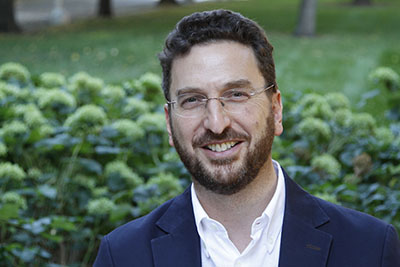
Alejandro Baer
Professor Alejandro Baer, now from the University of Minnesota, was first attracted to USC Shoah Foundation in 2000, when it was titled Survivors of the Shoah Visual History Foundation and was deep into its project to collect 50,000 testimonies of Holocaust survivors around the world.
Baer worked for five months in the translations office and became interested in focusing on the Shoah Foundation’s work for his ethnographic dissertation. He was particulary interested in the different approaches and outcomes of visual testimony methodologies and how the Visual History Archive understanding of testimony and methodological guidelines were received and implemented in different cultural contexts.
“The very content of testimony, the expression of emotions, the interaction between interviewer and interviewee vary across countries and languages and the study of this extraordinary project that was collecting testimonies in the entire world was the perfect case study for me,” Baer said.
In his research, he noticed differences in how testimonies were carried out around the world. The Shoah Foundation had very specific guidelines for the format of each interview and how to create awareness of the project in local Jewish communities, but these procedures often varied from place to place in response to different cultures.
“Particularly outside the US things sometimes looked differently,” Baer said. “Judicious regional coordinators and intervieweres served as translators between the US based project and its local implementation and creatively navigated between these different social worlds, where not just a data collection method was at stake but the local way of dealing with Holocaust memory.”
For his research Baer interviewed interviewers and regional coordinators from Argentina, Amsterdam, Frankfurt, Brazil and the US. Baer served as a camera assistant and later was an interviewer himself in Spain. He explored questions such as: To what extent is testimony a universal genre? What different meanings (historical, educational, ethical) do people assign to video testimony? How are video testimonies received, processesed (through film, exhibits and archives) and interpreted in different contexts?
His research was ultimately published in two books in Spanish: El Testimonio Audiovisual. Imagen y Memoria del Holocausto, and Holocausto.Recuerdo y Representacion. Since the publication, he has worked with other video testimony projects that came to him for advice and assistance, and noted that the Visual History Archive served as a model case for other video testimony archives in Spain inlcuding one about the ETA basque terrorist group and others focusing on the victims of Franco during the Spanish Civil War.
“Here I found fascinating how a model for testimonies of survivors of the Shoah was adopted for other cases of political violence, such as terrorism or war crimes,” Baer said.
Today, Baer is Stephen C. Feinstein Chair & Director of the Center for Holocaust and Genocide Studies and Associate Professor, Department of Sociology, at University of Minnesota. He has taught using the Visual History Archive at previous positions in Spain and Germany, and in Minnesota he and his colleagues use testimony throughout their courses. In June 2015, the library held a session on the archive during a Summer Institute Baer and his colleagues organized for educators from the Midwest titled “Holocaust Education in a Global Context.”
Fifteen years after he first began working at the Survivors of the Shoah Visual History Foundation, Baer is still fascinated by the Visual History Archive.
“As a sociologist what I find most interesting in testimony are the aformentioned aspects – how remembered experience becomes narrative (either in text or in voice and gesture), how these narratives are culturally shaped and anchored in time and context, how they evolve over time, how they impact on people, how we cherish and value them,” Baer said.